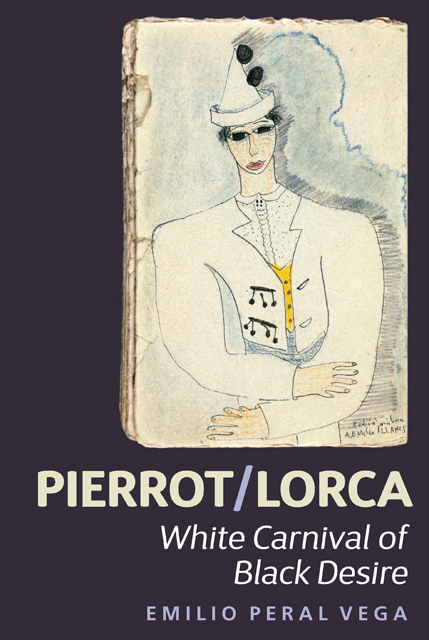Book contents
- Frontmatter
- Dedication
- Contents
- List of Illustrations
- Acknowledgements
- Prologue
- 1 A Modern Mask: From Deburau to The Tramp
- 2 First Examples of an Effeminate Pierrot: From Verlaine to Lorca
- 3 Pierrot/Lorca: Alter Ego for a Young Poet
- 4 Lorca/Pierrot: Between Painting and Theatre
- 5 Love Game and Masquerade: Dalí/Lorca
- 6 Perlimplín/Lorca/Pierrot: Frustrated Desire
- 7 A White Clown for a Black Desire: El público and Así que pasen cinco años
- Epilogue
- Bibliography
- Index
- Frontmatter
- Dedication
- Contents
- List of Illustrations
- Acknowledgements
- Prologue
- 1 A Modern Mask: From Deburau to The Tramp
- 2 First Examples of an Effeminate Pierrot: From Verlaine to Lorca
- 3 Pierrot/Lorca: Alter Ego for a Young Poet
- 4 Lorca/Pierrot: Between Painting and Theatre
- 5 Love Game and Masquerade: Dalí/Lorca
- 6 Perlimplín/Lorca/Pierrot: Frustrated Desire
- 7 A White Clown for a Black Desire: El público and Así que pasen cinco años
- Epilogue
- Bibliography
- Index
Summary
The performance ends and we look to the stage, asking ourselves if we have succeeded in dropping the mask; have we founded a ‘teatro bajo la arena’ in which the faces and bodies express, without restriction, all of their repressed impulses, where at last no one would be surprised, as Lorca hoped in his prologue to La zapatera prodigiosa, if ‘un árbol, por ejemplo, se convierta en una bola de humo ode que tres peces, por amor de una mano y una palabra, se conviertan en tres millones de peces para calmar el hambre de una multitud’ (García Lorca, 1997a: 196). We are not the ones who must find this solution. The work is only successful if we have at least raised many other new questions. This was the primary intention of this book: to present the reader with the history of an imperfect and archetypal mask that Federico García Lorca used as a reflection to attempt to explain himself both to himself and to a world in which he consciously placed himself at the margins. However, Lorca is not merely one more in a long line of poets, playwrights, painters and even filmmakers to have adopted Pierrot – throughout the nineteenth century and, specifically in Spain the first three decades of the twentieth century – as a stereotype or a hackneyed image from France – the nation that reconfigured mime and turned it into an icon of modernity – to demonstrate to what degree they were up to date with the latest aesthetic trends. Quite the contrary, Pierrot was for Lorca at first a discovery – circa 1918 – and then an illumination related to the decadent and homoerotic portrait established by Paul Verlaine. For Lorca to take on the pitiful white-faced buffoon as an alter ego implied conceiving of future expectations as a succession of failures. However, at the same time, it meant adopting idealism and lyricism as the driving forces of his journey.
In his juvenilia, Pierrot is still an elusive mechanism used to split himself in two and, still in heterosexual terms, a projection by means of which he intended to suggest the tortured road of desire.
- Type
- Chapter
- Information
- Pierrot/LorcaWhite Carnival of Black Desire, pp. 139 - 142Publisher: Boydell & BrewerPrint publication year: 2015

